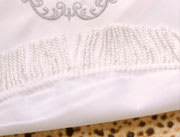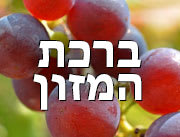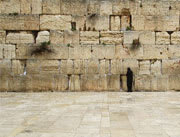 Kadesh
Kadesh
Rabbi Yerachmiel Morrison
The Seder establishes Kadesh (sanctification) before Urchatz (purification).
Wouldn’t the opposite order be more appropriate? Isn’t cleansing a prerequisite for holiness? In Tractate Avodah Zara we find that holiness is the ultimate and final goal reached after passing through numerous intermittent stages. How is it that on Passover, we are able to reach this goal even before that of purity?
This is testimony to the remarkable spiritual strength with which Passover imbues us. Normally any worthwhile goal, particularly a spiritual goal, requires a step-by-step process with painstaking attention to even the smallest detail. It is always a slow and exhausting climb. Pesach, however, opens up visions of remarkable transcendent excitement and yearning, which enable us to grasp an element of holiness that normally eludes, us and allows us to begin constructing a life on a more exalted and more passionate spiritual base.
Indeed, this is the very meaning of the word Pesach. Pesach means to skip over. This festival of faith enables us to, as it were, skip over, momentarily, the normal stages of spiritual growth and on this night to soar, to feel, to experience and to understand what previously had been beyond our embrace.
 Urchatz
Urchatz
Rabbi Yaakov Luban
Why do we not recite a bracha when washing our hands before dipping Karpas in salt water, as we do when washing for bread?
The requirement to wash one’s hands today, prior to eating dipped foods, is a matter of dispute among Poskim, but it was the common practice during the time of the Beit HaMikdash. Because of the conflicting viewpoints, when we wash for dipped foods, we do not recite a bracha.
Still, why does everyone wash their hands at the Seder for Urchatz, even though many do not normally do so with dipped foods all year round?
Rav Naftali Tzvi Berlin (known as the Netziv) offers a beautiful answer in the introduction to his magnificent commentary on the Haggadah, Imrei Shafer. The Seder reminds us of the eating of the Korban Pesach that took place when the Beit HaMikdash stood. Therefore, we follow the same halachic requirements at the Seder that were in place during the Temple era.
According to the Rosh, the Afikomen matzah is eaten in place of the Korban Pesach. Accordingly, one can suggest that at the Pesach Seder we do not only remember the Korban Pesach as a historical event last practiced 2,000 years ago. Rather, when we eat the Afikomen, we replicate the experience and feel the excitement of eating the Korban Pesach in Yerushalayim in close proximity of the Beit HaMikdash. As we relive this experience we are compelled to wash Urchatz, just as we did in the days of old.
 Karpas
Karpas
Rabbi Yitzchak Gutterman
The story of Joseph and his brothers is well known. Jacob gifted Joseph with a special coat called a (Ketonet Pasim). Rashi, commenting on that passage in the Torah, tells us that this clothing was made of wool. The Aramaic word (Karpas) also means wool.
Rabbeinu Manoach explains that at the Seder we dip the (Karpas) in salt water to remind us of Joseph’s coat, which was dipped in blood. The question is obvious. Why would we want to remember that most unfortunate episode at our Pesach Seder?
The story of Joseph and his brothers is the original symbol of — senseless hatred between fellow Jews—which resulted in our Egyptian exile and enslavement.
We are told that the (Korban Pesach) eaten at the Seder must be partaken of as a unified group, so on this night we remind ourselves of the misery that disunity can cause, and the need for harmony as one people to bring about our salvation.
Yachatz
Rabbi Nahum Rabinowitz
We take the middle matzah (representative of Yitzchak Avinu) and split it in two.
The following explanation for this step of the Seder was revealed to Rav Yosef Thumim in a dream. The Talmud records that the Almighty confronted our forefathers over the sins of their children. Neither Avraham nor Yaakov found a defense for our people. Yitzchak, though, had an answer:
Hashem confronted Yitzchak: “Your children have sinned against Me.”
Yitzchak responds: “Are they my children and not Your children?”
Yitzchak added: “If You carry half their sins I will carry the other half.”
The middle matzah symbolizes Yitzchak, and we split it in two, to symbolize the arrangement between Yitzchak and our Creator to share the burden of the Jewish People’s sins—enabling HaShem’s forgiveness.
 Maggid
Maggid
Rabbi Donneal Epstein
The most salient (and longest) part of the Passover Seder is Maggid, translated as “the telling over” or the “recitation.”
Maggid is introduced to us with the phrase, “This is the bread of affliction that our fathers ate in the land of Egypt. Whoever is hungry, let him come and eat. Whoever is in need, come and partake of the Passover offering.” Why is this invitation placed here at the beginning of Maggid? What is the connection?
The Netziv, in his commentary to Vayikra, explains the uniqueness of the Korban Todah (thanksgiving offering). Unlike other Shelamim (peace) offerings, which may be eaten for two days and the night in between, a Todah may only be eaten for one day! Additionally, it is to be accompanied by 40 loaves of bread. Why the shorter time span with so much more to consume?
The Netziv answers: so that the individual who brings a thanksgiving offering should invite others and relate to them the great kindness that God has performed for him. The inclusion of others will amplify the feelings of joy and gratitude for HaShem’s benevolence.
Similarly, on Passover we invite others to join immediately prior to the recital recounting the miracles that God performed for us, so we can laud Him in unison for his abundant kindness.
Rachtza
Rabbi Michoel Coleman
If we have already washed our hands at Urchatz, why the need to rewash our hands at this juncture?
The Haggadah is formulated to begin with describing our degradation and culminate with our acclaim—Matchil b’Genut U’Mesayim b’Shevach.
At this point of the Seder we are transitioning from the events describing our subjugation and humility into our deliverance and emancipation. Normally, when we wash and purify our hands, we need not decontaminate them a second time as long as we have been careful to consciously maintain their purity without diverting our attention.
The Seder’s transition from the story of Jews’ slavery to that of an exalted people is, in fact, a diversion—hence the requirement to cleanse our hands once again.
 Motzi
Motzi
Rabbi Moshe Klarburg
Motzi is simply the act of breaking bread at the outset of any meal. Why, then, is Motzi given a mention at all? Why is Motzi considered a vital component of the Seder?
Matzah is the simplest of foods, both in terms of its ingredients and the limitations placed on its processing. Nevertheless, it is transformed into the most exalted and cherished mitzvah of the entire evening. Even during the recital of the Haggadah, the text includes a reference to and explanation for the matzah, as if the Haggadah recital is a preamble to the matzah, and the matzah were the highlight of the Seder.
This analogy may be one of the most fundamental principles of the Seder. Starting out as slaves, dominated by a depraved and corrupt society, a nation miraculously emerged to become elevated and connected to HaShem, commissioned to enlighten the world with a new moral code.
From the most humble of foundations to the ultimate illustrious outcome—matzah and the Jewish People share a similar destiny.
 Matzah
Matzah
Rabbi Ben Zion Twerski
Our Sages, in tractate Pesachim, interpret the Torah’s reference to matzah as Lechem Oni (bread of poverty) as Lechem Sheonim alav Devarim Harbei—bread upon which many answers are given. The simple meaning of the words of our Sages is that matzah causes us to ask, “Why is this night different?” Indeed, the matzah gives us opportunities throughout the Seder night to respond and elaborate about the wonders of our exodus from Egypt and HaShem’s overwhelming love for His people.
My ancestor, Rabbi Sholom Rokeach, the first Belzer Rebbe, added another explanation for this term. He said that “bread upon which many answers are given” also indicates a Heavenly kindness. When Klal Yisrael fulfills the awesome mitzvah of eating the matzah on Pesach Eve, Heaven responds with many reactions—salvations to our difficulties and solutions to our challenges.
The Rebbe of Belz encourages every Jew, as we fulfill this great mitzvah of eating the matzah, to use the opportunity to appeal to the Almighty with our deepest wishes and prayers for ourselves, for those we love, and on behalf of all of the Jewish People.
 Maror
Maror
Rabbi Gad Buchbinder
On the Seder night, one reenacts Yetziat Mitzrayim and praises HaShem. Maror, the bitter herb, is eaten because the Egyptians embittered the lives of our ancestors during the Egyptian exile. Why do we eat Maror after Pesach and matzah? Would it not make more sense to follow the chronological sequence of the events in Egypt, first Maror, then Korban Pesach and finally matzah?
Yitro (Moshe’s father-in-law), upon joining the Jewish People in the desert, said “Thank HaShem that He saved you from the hand of Mitzrayim . . . on the matter [of the hardships] that they [the Egyptians] conspired on them [the Bnei Yisrael].” The Gemarah mentions that with those words Yitro was the first to praise HaShem for redeeming Bnei Yisrael from Mitzaryim, and criticizes Moshe and Bnei Yisrael for not doing so before then. But was Yitro really the first to praise HaShem? Did not the entire Bnei Yisrael, men and women, praise HaShem even before Yitro arrived, when they sang the Shira after Kiryat Yam Suf?
The Talmud tells us that blessings should be recited not just for happy events, but for certain negative situations as well. Such blessings require a deeper perspective and faith than a blessing on good news. Perhaps the uniqueness of Yitro’s praise was that it related not just to the redemption of the Jewish People, but also to the hardships that preceded it. Yitro was able to see the goodness of HaShem’s guidance even through the difficulties.
In a similar vein, the Seder starts with the easier aspect of praising HaShem for the rescue, which is represented by Pesach and matzah. Only after that can one aspire to contend with the Maror, praising Hashem for the hardships.
 Korech
Korech
Rabbi Yosef Grossman
The great orator and Rav of Lublin, Rav Meir Shapiro zt”l, was visiting Canada in the early 1930’s. An elderly Jew in Toronto recalls his fiery sermon from that time. The rumblings of the diabolically evil Hitler Y’S and his fellow Nazi cohorts had begun. The Jews living in Canada and the U.S. lived complacently in the environs of these two “kingdoms of kindness.” The time of year was right before Passover. Rav Shapiro used Maror and korech as metaphors to explain to his audience the difference between Europe and North America, at that time, concerning anti-Semitism.
Maror is the reviled “bitter herb,” which we eat at the beginning of the meal on the Seder night. Hillel of old would follow the eating of Maror by taking two pieces of matzah and sandwiching the bitter herbs in between. This is korech, where the bitter herbs are there, but hidden from view.
“We in Europe,” said Rav Shapiro, “are experiencing Maror, the open and blatant anti-Semitism. You—Jews in Canada and America, who do not live with these daily atrocities—should not become complacent however, for under the surface lurks the korech type of Maror.
Rav Meir Shapiro zt”l explained this by reminding us of the prophetic statement of the rabbis, that it is an inviolable fact that Eisav hates Yaakov. This Torah truth does not, and will not, change. It is an incontrovertible concept we need to vigilantly accept and remember—no matter how events and situation may appear—until it becomes obsolete with the coming of Eliyahu HaNavi and the Mashiach speedily in our days!
 Shulchan Orech
Shulchan Orech
Rabbi Chananel Herbsman
Listed as one of the items in the Seder indicates that Shulcan Orech is a special event and not just another festive holiday meal. Why is this so?
It is well known that the Mishnah and Haggadah state that we must see ourselves as having come out of Egypt. This experience reaches its apex with the recitation of Hallel as an expression of our recognition of God’s performing these miracles on our behalf. Unique to this night, the Sages split the Hallel into two parts, with the meal sandwiched in between the beginning and end of Hallel. One reason for this was to help transform the meal from a regular yom tov dinner to a meal of redemption. Redemption requires Hallel; it is a response to the wondrous events of the evening.
Consequently, the status of the meal itself is elevated, as it too is now a part of this redemption/Hallel process. The Ramban refers to the meal as the time of redemption, exclaiming, “Is it possible to eat matzah/Korban Pesach and not recite Hallel?!” This gives the meal an entirely different character. According to the Rambam, it is meaningful to eat the entire meal reclining (not just the four cups and the matzah). It is all part of our expression of freedom on this night of geulah. The entire meal is an opportunity to express our freedom. This is one reason that the meal itself has as siman in the Seder night, Shulchan Orech. It is in fact part of the uniqueness of the night, not just another yom tov meal, but the meal of redemption.
 Tzafun
Tzafun
Rabbi Menachem Adler
Tzafun, which means hidden, is a reference to the matzah that was “hidden” away earlier after Yachatz, at the beginning of the Seder. We now eat this matzah, which is called Afikoman, which in Aramaic refers to dessert.
A few questions:
- Why is this step called Tzafun? Of what significance is it that the matzah was hidden?
- Would it not be more logical to call this stage Afikoman, which is the actual name of the matzah?
- Why is there a widespread custom for children to “steal” the Afikoman and hold it for “ransom” to extract presents from their parents?
- We are required not to overeat before consuming the Afikoman, so that the Afikoman will be eaten with an appetite. Why is this important?
- One may not eat after partaking of the Afikoman, so the taste of the matzah will linger on. Why do we want the taste of the matzah to remain with us?
Perhaps the underlying theme of Tzafun is that mitzvot are precious gifts from HaShem. Appropriately, the Afikoman is called Tzafun, to reflect that this mitzvah is hidden just as one would conceal a valuable treasure. We encourage our children to steal the Afikoman and demand a ransom, so that they, too, will recognize just how special the mitzvah is. The Afikoman is consumed with appetite, which demonstrates that we approach the mitzvah with desire.
Finally, because we value the experience, we hold on to the lingering taste of the matzah by not eating anything after this final desert.
Tzafun is a lesson to all mitzvot; although we observe mitzvot because we are commanded to do so by HaShem, we also recognize them as treasures to be revered and cherished.
 Barech
Barech
Rabbi David Jenkins
In the second paragraph of bentching, Nodeh L’cha, we give thanks to HaShem for taking us out of Mitzrayim. We say V’al Shehotzetanu—for that which you took us out of Egypt. Why does our bentching refer not to the exodus of our forefathers, but to our own emancipation?
Many of our holidays include the concept of pirsumei nisah—the obligation to publicize the miracles that we have benefited from. How do we do this? On Chanukah we light the menorah for all to see, on Purim we listen to Megillat Esther, and on Pesach we drink the four cups. The Alter of Kelm explains that we do this not just to recall the marvels that were performed for our ancestors, but to remind us of the wonders that are present all around us every day; Bayamim Hahem (in those days) Bazman Hazeh (in our own times).
“A person is obligated to envision himself as if he departed from Egypt.” How is this possible? Most of us have never even visited Egypt. The word ”Mitzrayim” translates to “constrictions.”
Each of us, as we journey through life, face all sorts of constriction; stress, difficulties, challenges, etc. As we sit at the Seder and recall what HaShem has done for our ancestors, we must also contemplate all that HaShem does for us every day, freeing us from all of our troubles—big and small.
Something to consider during bentching at the Seder—something to think about when bentching every day.
 Hallel
Hallel
Rabbi Yisroel Bendelstein
The Beit Halevi translates the verse in Hallel: “Odecha ki anitani v’Tahie li liyeshua” as “I give thanks to You for afflicting me, and being for me a salvation.” According to this translation, the word “anitani” is derived from the root inui, which means affliction. The Beit Halevi remarkably comments that this Hallel song not only praises God Almighty for our salvation, but more profoundly, we are forever grateful for the suffering that we endured, which served as a catalyst to bring glory to God through our redemption.
My father, of blessed memory, once commented to me that there are two unique brands of chazanut or Jewish liturgical music: The first type of chazzanut is known in Yiddish as zinging—or singing. This brand of chazanut is renowned for being sweet and melodious, stirring the congregation to sing along with the chazzan. The second brand of chazzanut is known in Yiddish as zauging—or saying. This brand of chazanut is renowned for just “saying” the prayers in such a way that arouses the listener—educing him to break down in tears.
In Hallel we do both: zing—sing, and zaugt—say. We zing—“sing” thanks and praise to God Almighty from the lyrics of our salvation. By the same token and with equal heartfelt devotion, Hallel enables us to zaugt—“say”— with profound gratitude and with tears in our eyes the lyrics of our suffering. These zauging—“saying”—lyrics express our deep-est appreciation and admiration to God for enabling us to be the instrument of His glorification through our redemption. Hallel’s dual praise of both redemption and slavery is what Pesach is all about, and is therefore an important aspect of the Seder.
 Nirtza
Nirtza
Rabbi Kalman Scheiner
A person who has conducted the Seder properly is found to be pleasing to Heaven—or Nirtza.
We conclude the Seder with the words, “Next Year in Yerushalayim,” and similarly at the end of the Neilah prayer on Yom Kippur we proclaim, “L’shanah Habah b’Yerushalayim Habenuyah.”
On Yom Kippur, following our day of fasting and prayers that have cleansed us of our sins, we are in the position to emit our deep-felt yearning to reunite with the Shechinah in the rebuilt Yerushalayim.
The Seder has comparable transformative powers; at the onset of the Seder, when we are still bound to the struggles of our Exile, it is through the prism of galut that we cry out to HaShem in a more limited fashion, to redeem us and transport us to the Holy Land. However at the conclusion of the Seder, we are elevated and uplifted to a majestic level; we have experienced a spiritual awakening, and we are no longer bound to our location in galut. We are now ready to beseech HaShem with an earnest appeal: “Next year in the rebuilt Yerushalayim!”
The Jew, for whatever limitations and burdens, having experienced the day of Yom Kippur and celebrated the Pesach Seder, has most certainly found favor in the Creator’s eye. Never in the Jewish calendar are we closer to the redemption of Mashiach than at these two unique moments.




